This pub stands, more or less, on the site of an old alleyway, known as Baxter’s Court, which dates from at least 1700. Jerusalem Square also dated from this time, but both were swept away when Valetta Street (once Jerusalem Passage) was developed.
A collection of prints and text about Baxter’s Court.
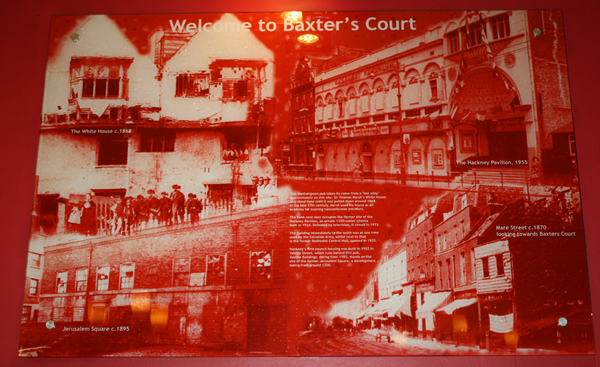
The text reads: This Wetherspoon pub takes its name from a “lost alley” approximately on this site. Sir Thomas Marsh’s White House, also stood here until it was pulled down around 1869. In the late 17th century, Marsh used his house as an academy for training nonconformist ministers.
The bank next door occupies the former site of the Hackney Pavilion, an ornate 1100-seater cinema built in 1914. Defeated by television, it closed in 1973.
The building immediately to the south was at one time used by the Salvation Army, whilst next to that is the former Methodist Central Hall, opened in 1925.
Hackney’s first council housing was built in 1902 in Valette Street, which runs behind this pub. Valette Buildings, dating from 1905, stands on the site of the former Jerusalem Square, a development dating from around 1700.
Individual images are entitled (clockwise, from top left): ‘The White House c. 1868’; ‘The hackney Pavilion, 1955; ‘Mare Street c. 1870 looking towards Baxters Court’; ‘Jerusalem Square c. 1895’.
A collection of prints and text about local landmarks.
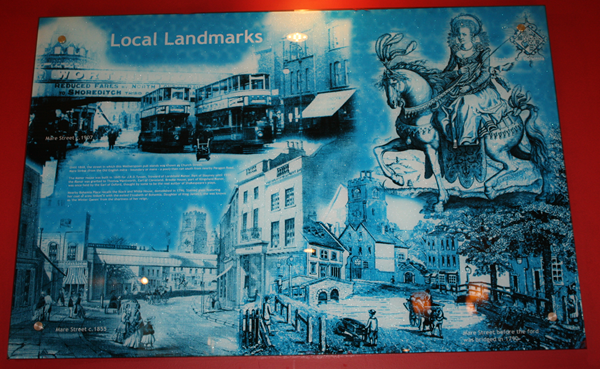
The text reads: Until 1868, the street in which this Wetherspoon pub stands was known as church street. Mare Street (from the Old English mere – boundary or mere – a pool then ran south from nearby Paragon Road.
The Manor House was built in 1845 for J.R.D. Tyssen, Steward of the Lordshold Manor. Part of Stepney until 1558 the Manor was granted to Thomas Wentworh, Earl of Cleveland. Brooke House, part of Kingshold Manor, was once held by the Earl of Oxford, thought by some to be the real author of Shakespeare’s plays.
Nearby Bohemia Place recalls the Black and White House, demolished in 1796. Stained glass featuring her coat of arms linked it with the exiled Elizabeth of Bohemia. Daughter of King James I, she was known as ‘the Winter Queen’ from the shortness of her reign.
The individual images are entitled (clockwise, from top left): ‘Mare Street c. 1907’; ‘Elizabeth of Bohemia’; ‘Mare Street before the ford was bridged in 1790’; ‘Mare Street c. 1855’.
A collection of prints and text about the Hackney Empire.
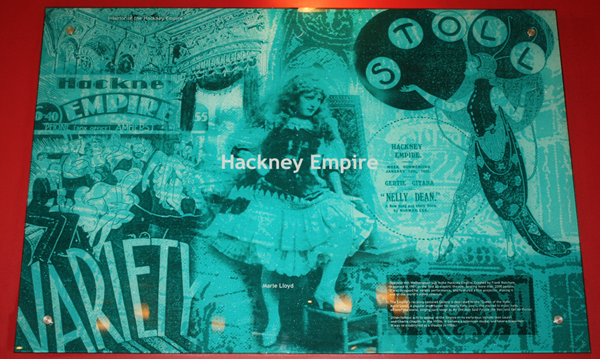
The text reads: Opposite this Wetherspoon pub is the Hackney Empire. Created by Frank Matcham, it opened in 1901 as the first all-electric theatre. Seating more than 2000 people, it was designed for variety performance, and featured a film projector, making it one of the world’s oldest cinemas.
The empire’s recently restored Gallery is dedicated to the “Queen of the Halls”, Marie Lloyd. A popular entertainer for nearly forty years, she starred in music halls all over the world, singing such songs as My Old Man Said Follow the Van; and Oh! Mr Porter.
Other famous acts to appear at the Empire in its early days include Stan Laurel and Charlie Chaplin. In the 1950s, it became a television studio, and later a Bingo Hall. It was re-established as a theatre in 1986.
The individual images are entitled (clockwise, from top left):
‘Interior of the Hackney Empire’ (top left) and ‘Marie Lloyd’ (centre).
A collection of prints and text about The New Mermaid.
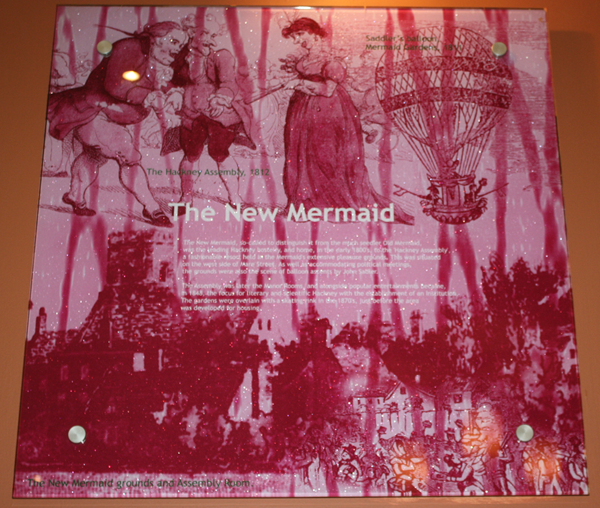
The text reads: The New Mermaid, so called to distinguish it from the much seedier Old Mermaid, was the leading Hackney hostelry, and home, in the early 1800s, to the Hackney Assembly, a fashionable resort held in the Mermaid’s extensive pleasure grounds. This was situated on the west side of Mare Street. As well as accommodating political meetings, the grounds were also the scene of balloon ascents by John Sadler.
The assembly was later the Manor Rooms, and alongside popular entertainments became in 1848, the focus for literary and scientific Hackney with the establishment of an institution. The gardens were overlain with a skating rink in the 1870s, just before the area was developed for housing.
The individual images are entitled (clockwise, from top left): ‘The Hackney Assembly, 1812’; ‘Saddler’s balloon Mermaid Gardens, 1811’; ‘The New Mermaid grounds and Assembly Room.’
A collection of prints and text about Ralph Sadlier and William Spurstow.
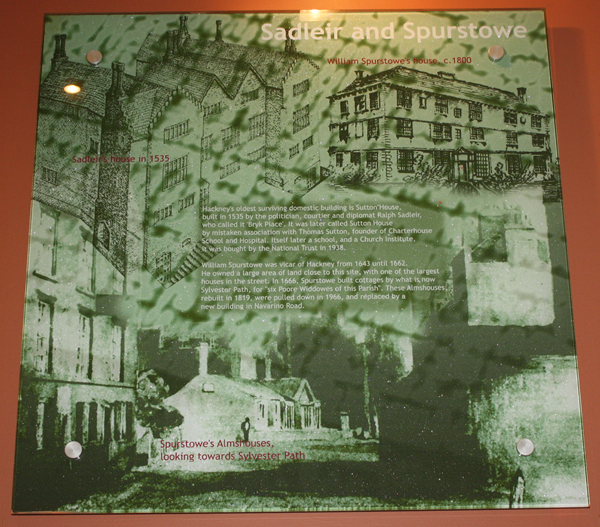
The text reads: Hackney’s oldest surviving domestic building is Sutton House, built in 1535 by the politician, courtier and diplomat Ralph sadleir, who called it ‘Bryk Place’. It was later called Sutton House by mistaken association with Thomas Sutton, founder of Charterhouse School and Hospital. Itself later a school, and a Church Institute, it was bought by the National Trust in 1938.
William Spurstowe was vicar of Hackney from 1643 until 1662. He owned a large area of land close to this sit, with one of the largest houses in the street. In 1666, Spurstowe built cottages by what is now Sylvester Path, for “six Poore Widdowes of this Parish”. These Almshouses, rebuilt in 1819, were pulled down in 1966, and replaced by a new building in Navarino Road.
The individual images are entitled (clockwise, from top left): ‘Sadleir’s house in 1535’; ‘William Spurstowe’s House, c. 1800; Spurstowe’s Almshouses, looking towards Sylvester Path.’
A collection of prints and text about Loddiges Nurseries.
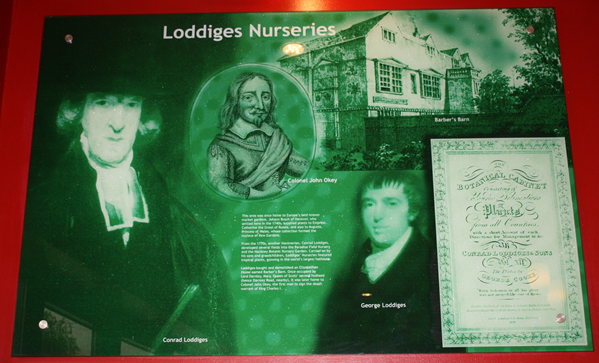
This area once home to Europe’s best-known market gardens. Johann Busch of Hanover, who settled here in the 1740s, supplied plants to Empress Catherine the Great of Russia, and also to Augusta, Princess of Wales, whose collection formed the nucleus of Kew Gardens.
From the 1770s, another Hanoverian, Conrad Loddiges, developed several fields into the Paradise Field Nursery and the Hackney Botanic Nursery Garden. Carried on by his sons and grandchildren, Loddgies’ Nurseries featured tropical plants, growing in the world’s largest hothouse.
Loddgies bought and demolished an Elizabethan House named Barber’s Barn. Once occupied by Lord Darnley, Mary, Queen of Scots’ second husband (hence Darnley Road, nearby), it was later home to Colonel John Okey, the first man to sign the death warrant of King Charles I.
The individual images are entitled (left to right): ‘Conrad Loddiges’; ‘Colonel John Okey’; ‘George Loddiges’; ‘Barber’s Barn’.
A collection of prints and text about The Templars’ House.
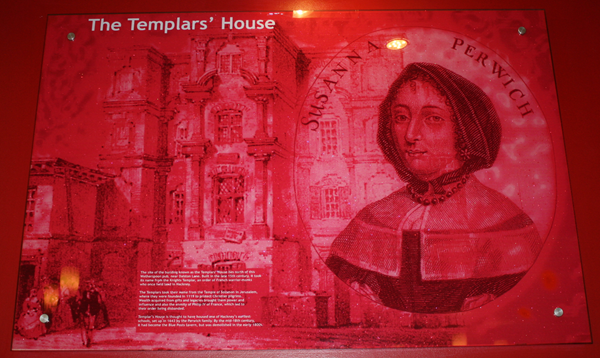
The text reads: The site of the building known as the Templars’ House lies north of this
Wetherspoon pub, near Dalston Lane. Built in the late 15th century, it took its name from the Knights Templar, an order of French warrior-monks who once held land in Hackney.
The Templars took their name from the Temple of Solomon in Jerusalem,
where they were founded in 1119 to protect Christian pilgrims. Wealth acquired from gifts and legacies brought them power and influence and also the enmity of Philip IV of France, which led to their order being disbanded.
Templar’s House is thought to have housed one of Hackneys earliest
schools, set up in 1643 by the Perwich family. By the mid-18th century, it had become the Blue Posts tavern, but was demolished in the early 1800s.
If you have information on the history of this pub, then we’d like you to share it with us. Please e-mail all information to: pubhistories@jdwetherspoon.co.uk